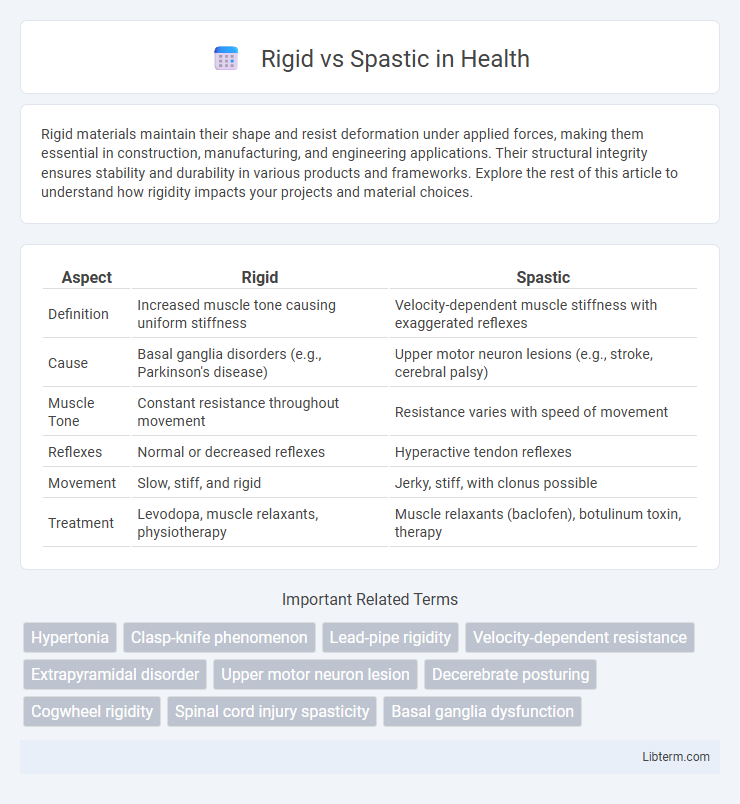Rigid materials maintain their shape and resist deformation under applied forces, making them essential in construction, manufacturing, and engineering applications. Their structural integrity ensures stability and durability in various products and frameworks. Explore the rest of this article to understand how rigidity impacts your projects and material choices.
Table of Comparison
| Aspect | Rigid | Spastic |
|---|---|---|
| Definition | Increased muscle tone causing uniform stiffness | Velocity-dependent muscle stiffness with exaggerated reflexes |
| Cause | Basal ganglia disorders (e.g., Parkinson's disease) | Upper motor neuron lesions (e.g., stroke, cerebral palsy) |
| Muscle Tone | Constant resistance throughout movement | Resistance varies with speed of movement |
| Reflexes | Normal or decreased reflexes | Hyperactive tendon reflexes |
| Movement | Slow, stiff, and rigid | Jerky, stiff, with clonus possible |
| Treatment | Levodopa, muscle relaxants, physiotherapy | Muscle relaxants (baclofen), botulinum toxin, therapy |
Introduction to Rigid and Spastic Conditions
Rigid conditions involve increased muscle tone causing stiffness and resistance to passive movement, commonly observed in disorders like Parkinson's disease. Spastic conditions are characterized by velocity-dependent muscle hyperactivity and exaggerated tendon reflexes, often resulting from upper motor neuron lesions such as cerebral palsy or stroke. Differentiating between rigidity and spasticity is crucial for accurate diagnosis and targeted rehabilitation strategies.
Defining Rigidity in Neuromuscular Disorders
Rigidity in neuromuscular disorders manifests as increased muscle tone causing resistance to passive movement, independent of velocity, often observed in Parkinson's disease. This sustained stiffness contrasts with spasticity, which is velocity-dependent and typically linked to upper motor neuron lesions. Recognizing rigidity involves assessing consistent resistance throughout the range of motion without the catch-and-release phenomenon seen in spastic muscles.
Understanding Spasticity: Key Features
Spasticity is characterized by velocity-dependent increase in muscle tone, resulting in stiff and awkward movements due to hyperactive stretch reflexes. It commonly affects individuals with central nervous system disorders such as cerebral palsy, multiple sclerosis, or stroke. Unlike rigidity, which presents as constant resistance regardless of movement speed, spasticity varies with the speed of muscle stretch and often leads to muscle spasms and contractures.
Causes of Rigidity and Spasticity
Rigidity is primarily caused by extrapyramidal system damage, commonly seen in Parkinson's disease, where basal ganglia dysfunction leads to increased muscle tone and resistance to passive movement. Spasticity originates from upper motor neuron lesions affecting the corticospinal tract, often due to stroke, multiple sclerosis, or spinal cord injury, resulting in velocity-dependent muscle tightness and hyperactive stretch reflexes. Differentiating between rigidity and spasticity aids in targeted neurological diagnosis and treatment planning.
Clinical Manifestations: How Rigidity and Spasticity Present
Rigidity presents as uniform resistance to passive movement throughout the entire range of motion, often described as cogwheel or lead-pipe rigidity, frequently observed in Parkinson's disease. Spasticity is characterized by velocity-dependent increase in muscle tone, with resistance that intensifies during rapid stretch and is commonly associated with upper motor neuron lesions such as stroke or cerebral palsy. Clinically, rigidity affects both agonist and antagonist muscles uniformly, while spasticity typically involves hyperactive stretch reflexes and brisk tendon jerks localized to specific muscle groups.
Pathophysiological Differences Between Rigidity and Spasticity
Rigidity is characterized by increased muscle tone due to hyperactivity of both flexor and extensor muscles, stemming from basal ganglia dysfunction, often seen in Parkinson's disease. Spasticity involves velocity-dependent increased muscle tone resulting from hyperexcitability of the stretch reflex caused by upper motor neuron lesions, commonly associated with conditions like cerebral palsy and stroke. The pathophysiological divergence lies in rigidity's non-velocity-dependent resistance and bilateral muscle involvement versus spasticity's velocity-dependent resistance predominantly affecting antigravity muscles.
Diagnostic Approaches for Differentiating Conditions
Differentiating rigid and spastic muscle tone involves evaluating clinical signs such as resistance patterns and reflex responses, with rigidity presenting as constant resistance and spasticity exhibiting velocity-dependent resistance. Diagnostic methods include neurological examinations, electromyography (EMG), and imaging techniques like MRI to assess underlying central nervous system lesions. Accurate differentiation supports targeted therapeutic strategies, improving patient outcomes in conditions such as Parkinson's disease and upper motor neuron disorders.
Treatment Options for Rigidity and Spasticity
Treatment options for rigidity often include dopaminergic medications such as levodopa and muscle relaxants like baclofen to reduce muscle stiffness and improve mobility. Spasticity management frequently involves physical therapy, stretching exercises, and pharmacological interventions including tizanidine and intrathecal baclofen pumps to target hyperactive reflexes. Both conditions may benefit from botulinum toxin injections to alleviate localized muscle overactivity and enhance functional outcomes.
Rehabilitation Strategies and Management
Rehabilitation strategies for rigid and spastic muscle conditions vary significantly, with spasticity management emphasizing stretching, strengthening exercises, and use of antispastic medications like baclofen or botulinum toxin to reduce muscle overactivity. Rigid muscle rehabilitation focuses on mobilization techniques, passive range of motion exercises, and physical modalities such as heat therapy to improve muscle stiffness without excessive tone. Multidisciplinary approaches combining physical therapy, occupational therapy, and, in some cases, surgical interventions optimize functional outcomes for patients with either rigidity or spasticity.
Prognosis and Quality of Life Considerations
Rigid and spastic muscle conditions differ significantly in prognosis and quality of life impact, with rigidity often linked to Parkinson's disease and slower progression, while spasticity commonly results from upper motor neuron lesions such as stroke or cerebral palsy, frequently causing fluctuating muscle tone and spasms. Prognostic outcomes for rigidity tend to show gradual functional decline but better responsiveness to dopaminergic treatments, whereas spasticity prognosis varies widely based on underlying causes and may require multidisciplinary management including physical therapy, medications, and occasionally surgical interventions. Quality of life considerations for rigidity focus on mobility maintenance and tremor control, while spasticity management emphasizes preventing contractures, reducing pain, and enhancing voluntary movement through targeted rehabilitation strategies.
Rigid Infographic

 libterm.com
libterm.com